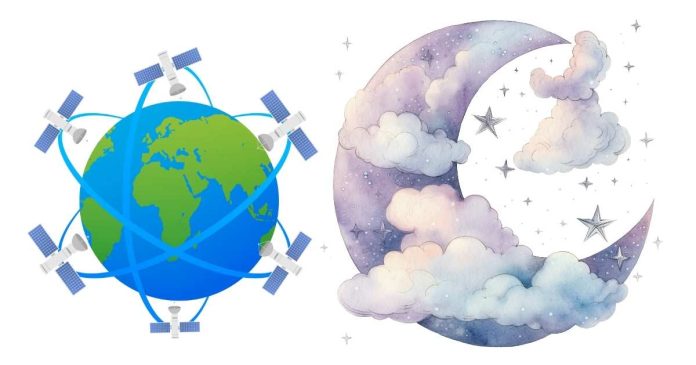1. The Moon
- Overview: The Moon is Earth’s only natural satellite, and it’s the fifth-largest moon in the Solar System. It has a significant effect on Earth, particularly in the areas of tides, stabilizing Earth’s axial tilt, and influencing the length of our days.
- Size: The Moon has a diameter of about 3,474 km, which is about 1/4th the size of Earth.
- Distance from Earth: It orbits Earth at an average distance of about 384,400 kilometers (238,855 miles).
- Orbital Characteristics: The Moon completes one orbit around Earth every 27.3 days and has a synchronous rotation, meaning the same side always faces Earth. This is due to tidal locking.
2. 2006 RH120
- Overview: 2006 RH120 was a small asteroid that temporarily became a quasi-satellite of Earth. It was discovered in 2006 and orbited Earth for a short period.
- Size: Estimated to be around 2 to 3 meters in diameter, making it very small compared to the Moon.
- Orbital Characteristics: This asteroid was in an Earth orbit for about a year (2006–2007). It was briefly captured by Earth’s gravity and moved into an orbit that was close to Earth’s, but it eventually left the Earth’s gravitational influence and became an independent asteroid again.
- Temporary Satellite: While it was temporarily in Earth’s orbit, it wasn’t a true satellite since it didn’t stay for a long time like the Moon. It’s more accurately called a “temporarily-captured object” (TCO).
3. 2016 HO3
- Overview: 2016 HO3 is a small asteroid that has been in a stable orbit around the Earth for many years. It is often referred to as a “quasi-satellite” because it shares Earth’s orbit around the Sun but does not stay in a strict orbit around Earth. It is considered one of the closest known quasi-satellites of our planet.
- Size: This asteroid is about 40 meters in diameter.
- Orbital Characteristics: Unlike 2006 RH120, 2016 HO3 does not enter Earth’s gravitational influence for an extended period but orbits the Sun in a path that is very close to Earth’s orbit. Its orbit is such that it is “trapped” in a kind of dynamic equilibrium with Earth. It stays at a distance that is about 38 million kilometers away from Earth (about 0.25 AU).
- Orbit Details: 2016 HO3’s orbit is more complex than just circling Earth. It orbits the Sun along with Earth, but the asteroid oscillates around the Earth-Sun line, appearing to move in a figure-eight pattern when viewed from Earth. This makes it seem like it is in a co-orbital relationship with Earth.
Conclusion:
While the Moon is Earth’s only permanent natural satellite, objects like 2006 RH120 and 2016 HO3 are examples of temporarily captured objects or quasi-satellites. These objects are not true moons in the long term but are gravitationally linked to Earth for a time, making them interesting cases of temporary satellite relationships.


